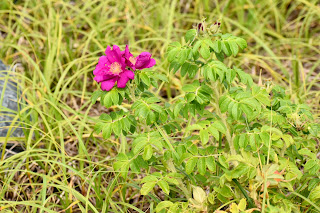Today I drove down to the end of Island Beach State Park in the morning just to see if anything interesting had turned up ahead of the predicted thunderstorms. It turned out to be rather uneventful. There were the usual and expected sea birds around, but little else bird-wise. Most of the shorebirds have not yet returned from their northern breeding grounds. But a walk towards the back of the inlet provided me with some sightings to share.
Besides the seaside pea and poison ivy that line the beaten path heading towards the end of the jetty, some colorful plants were noticeable. Rugosa roses and virgin creepers were sporting red colors. Hoary mugwort, now past its flowering stage, was lush in its minty blue hue.
Rugosa rose, or beach rose, is an introduced species from Asia. © S. Weiss
Left, a virgin creeper (genus name), most likely Virginia creeper. Right, hoary mugwort, a naturalized coastal plant. © S. Weiss
I did not see many butterflies or moths today, maybe because there was a decent south wind coming across the inlet that probably kept them either deep within the flora or sheltered on the leeward side of the dunes. Luckily the wind kept the mosquitoes and greenhead flies away too. I did identify, with the aid of my
Seek app, two other insects today: an
efferia albibarbis and a
microbembex monodonta, or more commonly, a sand bee.
Efferia albibarbis. © S. Weiss
Efferia albibarbis doesn't have a common name, but it is a species of robber fly. They hunt on the wing, snatching prey out of the air.
Microbembex monodonta. © S. Weiss
Microbembex monodonta is commonly called the sand bee or sand wasp.
At the end of the jetty, the tide was out and there were sandbars exposed, as well as the now deteriorated geo tubes. The geo tubes were large canvas-like bags filled with sand and put in place to help control erosion. It’s still early in the summer, so not much was out on the sandbars except for the usual gulls, terns, double-breasted cormorants and some American oystercatchers. I did not see any pelicans either, but I know by late August and early September there will be well over a hundred of them. A large group of laughing gulls and about two dozen glossy ibis were foraging along the edge of the water, most likely on the remnants of horseshoe crab eggs. The lack of shorebirds roaming around the flats allowed the fiddler crabs to venture out of their burrows at the edges of the marsh grasses.
Atlantic sand fiddler crab. © S. Weiss
The male fiddler crab is recognizable by its large fiddle claw. The male waves its fiddle to either entice a female or warn another male. If the male loses its fiddle, its smaller claw will grow to fiddle size, and a new smaller claw will regenerate from the lost claw.
American oystercatcher with leg bands (KU). © S. Weiss
Local seaweeds of Barnegat Bay and Inlet. © S. Weiss
Left, broadleaf sea lettuce. Right, bladder wrack. Broadleaf sea lettuce is edible. In the late summer, bladder wrack can be a sanctuary for juvenile crabs, fish and other marine organisms. It is also a source of vitamins and minerals, such as iodine.
Small horseshoe crab skeleton. © S. Weiss
Either the molted shell of a growing horseshoe crab, or the corpse of young one.
Geo tube. © S. Weiss
An exposed geo tube near the Sedge Islands behind Island Beach. There probably is a more accurate industry standard name for bio tubes. They were made of permeable fabric and filled with dredged sand. This one looks very much like a beached whale.
My walk ended when I got back to the ocean side of the inlet. A few more scans of the ocean did not find any other birds. Just as well as the clouds were building and darkening. Before I drove off, I did spot a laughing gull on the beach with an object hanging from its bill. It was rather long and slender and, at first, I thought it was a sand eel. The bird dropped it momentarily on the beach and I was able to get a picture of its meal. It wasn’t a sand eel. It looked as if the fish had propped itself up on the sand. I had to enlarge my photo and it appeared to be some type of trumpet fish. The bird may be ho-hum, but it’s prey was pretty cool.
Laughing gull with its prey that looks like a type of trumpet fish, but is actually a large northern pipefish. © S. Weiss

















Comments
Post a Comment